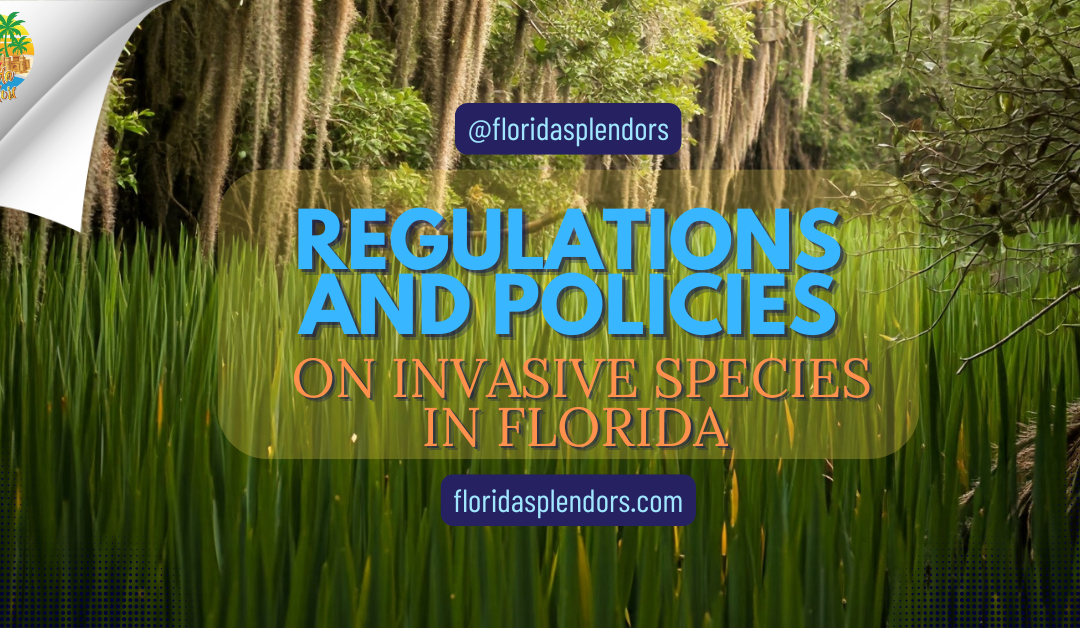==================
Florida Splendors is supported by our audience. When you purchase through one of our links, we may earn a small affiliate commission. As an Amazon Associate I earn from qualifying purchases. Your cost is not affected.
Regulations and policies on invasive species in Florida play a crucial role in protecting the state’s ecosystems, as these harmful non-native species threaten native plants, animals, and local economies. From Burmese pythons to Brazilian pepper trees, these invasive species can spread rapidly, outcompeting native wildlife and causing long-term environmental damage. In response, Florida has developed strict measures aimed at controlling and preventing the introduction of invasive species. However, understanding these rules can be overwhelming, as they cover many areas, including land management, wildlife trade, and habitat preservation.
For property owners, outdoor enthusiasts, or anyone concerned about Florida’s natural beauty, staying informed about these regulations is essential. This article will explore the key policies designed to curb the spread of invasive species, highlighting how they work and why they matter. More importantly, it will offer practical steps to help protect Florida’s unique landscapes and wildlife from further harm.
Regulations and Policies on Invasive Species in Florida: Protecting Our Sunshine State’s Ecosystems
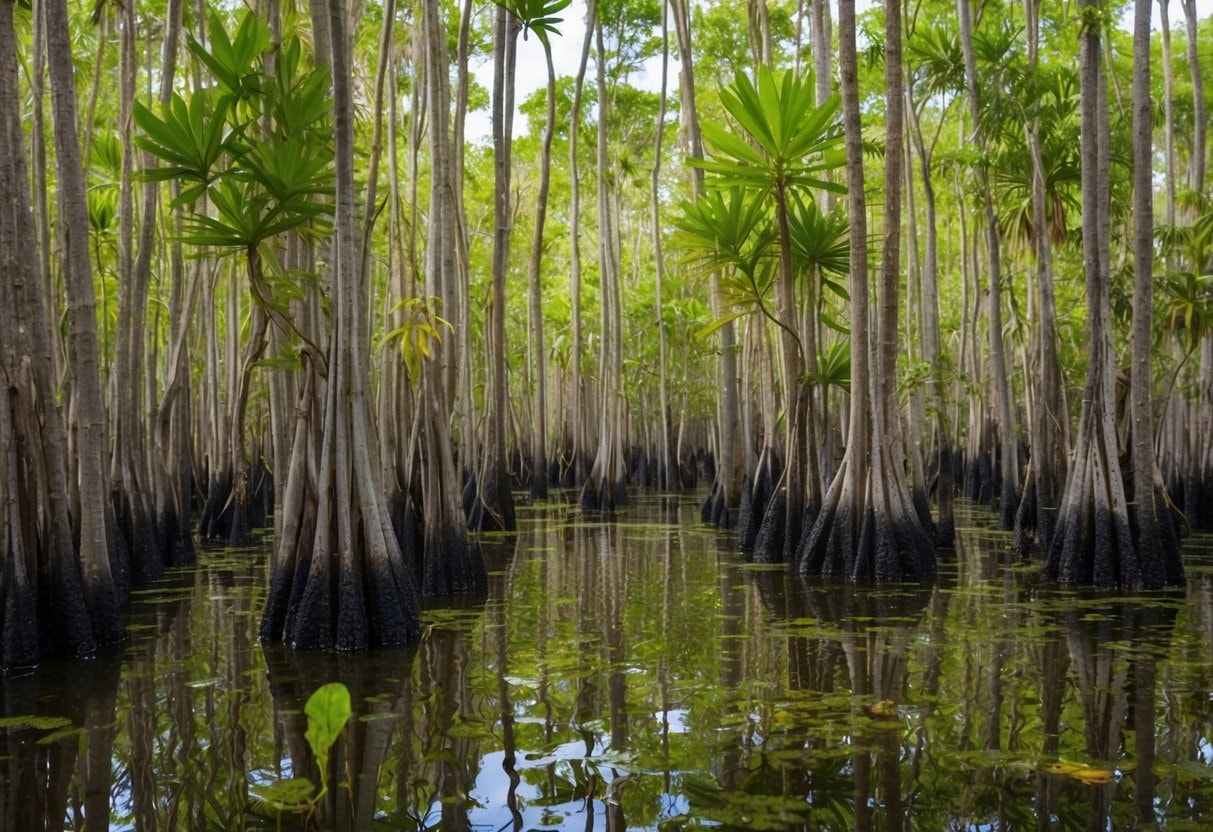
Florida faces unique challenges with invasive species due to its warm climate and diverse ecosystems. The state has implemented various regulations and policies on invasive species in Florida to manage non-native species that threaten native wildlife and habitats.
These rules aim to prevent the introduction and spread of harmful plants and animals while protecting Florida’s natural environment. Invasive reptiles like pythons and iguanas have gained significant attention in recent years.
The Florida Fish and Wildlife Conservation Commission (FWC) has taken steps to address these issues by prohibiting several invasive reptile species. These measures include restrictions on ownership, breeding, and sale of certain non-native animals.
The state also focuses on early detection and rapid response to new invasive threats. One example is the giant African land snail, which was successfully eradicated twice in Florida. Ongoing monitoring and control efforts help minimize the impact of invasive species on the state’s ecology and economy.
Key Takeaways
- Florida has implemented strict regulations to prevent the introduction and spread of harmful non-native species, safeguarding its unique ecosystems and native wildlife.
- The state prohibits the ownership and breeding of several invasive reptiles, including Burmese pythons and green iguanas, to limit their impact on local habitats.
- Effective management of invasive species relies on early detection and rapid response, illustrated by successful eradication efforts like that of the giant African land snail.
- Programs like the Exotic Pet Amnesty Program and Cooperative Invasive Species Management Areas (CISMAs) encourage public participation in managing and reporting invasive species.
- Florida promotes education and awareness about invasive species through outreach initiatives, training programs, and partnerships to empower residents to protect the environment.

Historical Context of Invasive Species in Florida
Florida has a long history of invasive species. The Sunshine State’s warm climate and diverse ecosystems make it an ideal home for many non-native plants and animals, so regulations and policies on invasive species in Florida have become essential in controlling the spread and impact of these harmful organisms.
In the 1960s, green iguanas were first spotted in Florida. These large lizards quickly spread throughout the state, becoming a common sight in many areas. The 1980s saw the introduction of Burmese pythons. These massive snakes were initially kept as pets. Some were released into the wild, where they thrived, especially in the Everglades.
These and other invasive species have significantly impacted Florida’s unique biodiversity. Native plants and animals often struggle to compete with these newcomers. Over time, Florida’s government and wildlife agencies have developed regulations to address the problem of invasive species. These rules aim to protect the state’s natural ecosystems.
Today, Florida continues to face challenges from invasive species. However, increased awareness and better management practices are helping to protect the state’s natural beauty and biodiversity.
Overview of Invasive Species Legislation
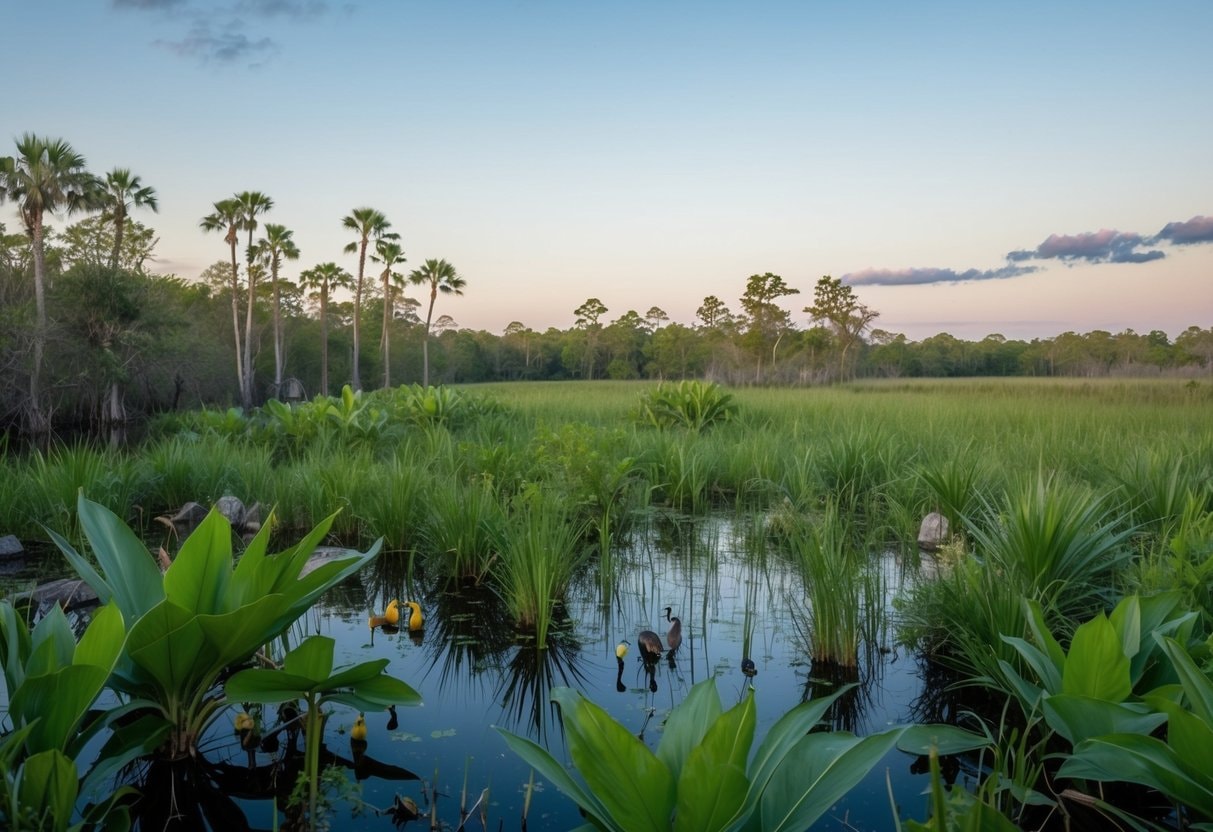
Florida has several regulations and policies on invasive species in Florida to control invasive species. These regulations aim to protect the state’s native wildlife and ecosystems. Recent changes have added new species to the prohibited list and updated existing rules.
Key Regulations and Their Effective Dates
The Florida Fish and Wildlife Conservation Commission oversees many invasive species rules. A key regulation is Chapter 68-5 of the Florida Administrative Code. This chapter deals with conditional and prohibited non-native species. On April 29, 2021, new rules went into effect.
These rules banned owning or breeding certain invasive reptiles. The list includes tegu lizards, green iguanas, and several python species. Another important date is July 28, 2021. On this day, more species were added to the prohibited list. This update aimed to stop the spread of invasive plants and animals.
Recent Amendments and Additions
In October 2021, Florida made more changes to its invasive species rules. These new rules allow some flexibility in caging requirements. Groups can now ask for different cage setups if needed.
The state also created new permit options. These allow people to keep some banned species for special reasons. But the rules are strict to prevent escapes. Florida keeps updating its laws as new invasive threats appear. The goal is to balance human activities with protecting native ecosystems.
Invasive Reptiles and Amphibians
Florida faces challenges from non-native reptiles and amphibians. These animals harm local ecosystems and wildlife. To address these issues, the state has implemented regulations and policies on invasive species in Florida to control their spread and minimize the impact on native habitats.
Iguanas and Tegus
Green iguanas and tegus are big problems in Florida. Green iguanas dig burrows that damage seawalls and sidewalks. They also eat plants in gardens and parks. Tegus are large lizards that eat small animals and birds’ eggs.
They’re a threat to native species. Both iguanas and tegus are now banned as pets in Florida. People who already own these lizards can keep them but can’t buy new ones. The rules aim to stop these reptiles from spreading more in the wild.
Pythons and Cane Toad
Pythons, especially Burmese pythons, have taken over parts of the Everglades. These huge snakes eat many native animals. They’re very hard to find and remove. New rules ban people from owning pythons as pets. This helps stop more pythons from escaping into the wild.
Cane toads are another big problem. They’re not reptiles, but they’re just as harmful. These toads are poisonous to pets and native animals. They breed fast and eat almost anything. Florida is working to teach people how to spot and safely remove these invasive species. The goal is to protect the state’s unique ecosystems and wildlife.
Check out this documentary video on the invasive species of Florida.
By: Marwan Enezi
Regulation of Pet Ownership
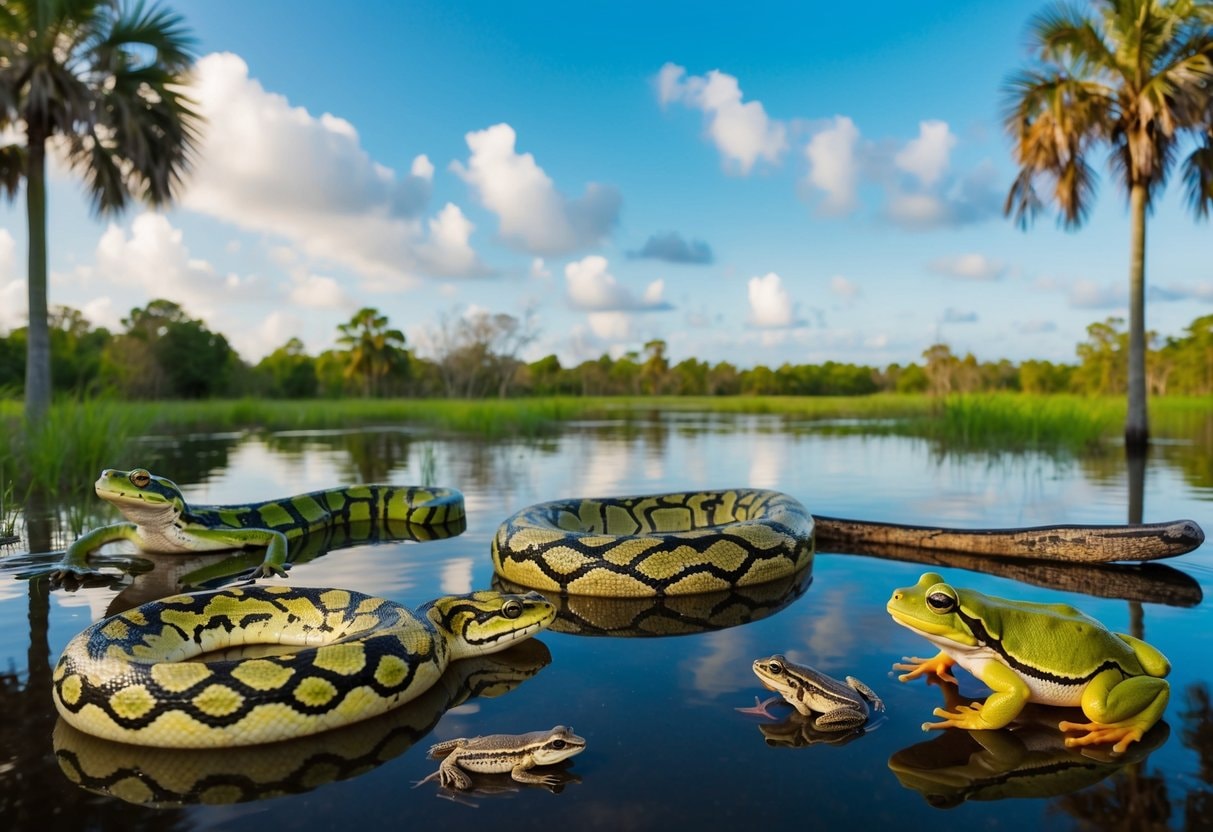
Florida has strict regulations and policies on invasive species in Florida, especially regarding the ownership of exotic animals as pets. These rules aim to protect both the public and the environment from invasive species. Pet owners need special permits and must follow specific caging guidelines.
Permits and Pet Owner Responsibilities
Pet owners in Florida need permits to keep certain exotic animals. These permits help track non-native species in the state. To get a permit, owners must show they can care for the animal safely. Owners must also prevent their pets from escaping. This is crucial to stop the spread of invasive species.
If a pet gets loose, owners must report it right away. Some animals are now off-limits as pets. For example, Florida banned new ownership of tegus and green iguanas in 2021. People who already owned these animals could keep them with the proper permit.
Caging Requirements and Restrictions
Florida has strict rules about how exotic pets must be housed. These rules keep both the animals and the public safe. Indoor cages must be escape-proof. They need solid locks and secure walls. Outdoor enclosures have even stricter rules. They must withstand Florida’s harsh weather, including hurricanes.
Cage sizes depend on the animal’s type and size. Bigger animals need more space. Some pets require special features in their cages, like pools for water-loving species. The Florida Fish and Wildlife Conservation Commission can approve changes to standard caging rules. Owners must ask for these changes in writing. They need to explain why they need different caging.
Management and Eradication Efforts
Florida takes regulations and policies on invasive species in Florida seriously. Teams work hard to remove harmful plants and animals. They also teach people about the problem.
Research and Conservation Initiatives
The University of Florida leads research on invasive species. They study how these plants and animals spread. They also test new ways to stop them. Scientists look at how invasives harm local plants and animals. This helps them know which species to focus on first.
Teams use special tools to find invasive species early. This makes it easier to remove them before they spread too far. Experts share what they learn with other states. This teamwork helps everyone fight invasives better.
Community Outreach and Education
Florida teaches people about invasive species. They want everyone to help spot and report them. Schools have fun programs to teach kids. They learn why native plants and animals are important. Fishing and hiking groups get special training. They can spot new invasive species while enjoying nature.
The state has websites with pictures of invasive plants and animals. People can use these to check what they see outside. Local nature centers hold events to remove invasive plants. This lets people help fix the problem hands-on.
Programs and Partnerships
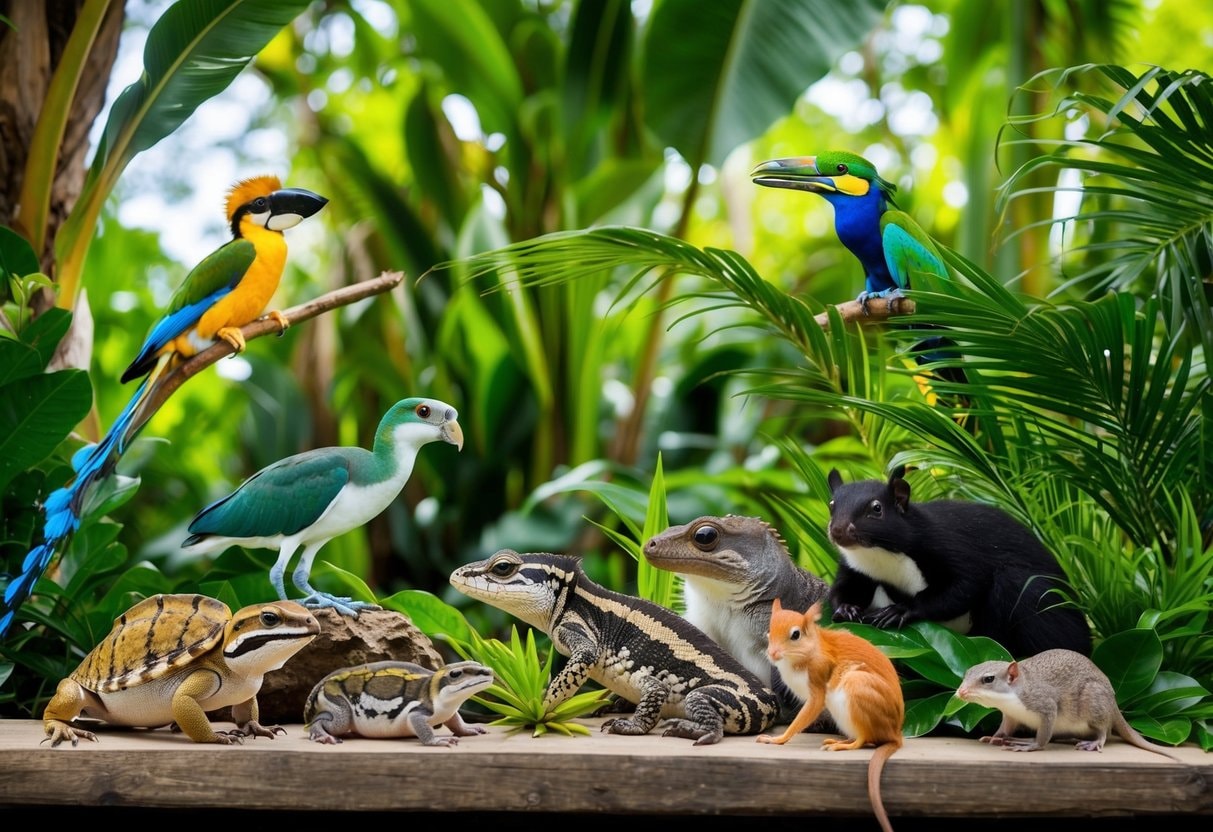
Florida has several key programs to manage invasive species. These initiatives focus on community involvement and regional coordination to tackle the spread of non-native plants and animals, all while aligning with the regulations and policies on invasive species in Florida.
Exotic Pet Amnesty Program
The Exotic Pet Amnesty Program helps pet owners who can’t keep their exotic pets. It gives them a safe way to give up their animals without letting them go in the wild. This program is important because it stops pets from becoming invasive species. The Florida Fish and Wildlife Conservation Commission runs this program.
They hold events where people can bring their exotic pets. Experts check the animals’ health and find new homes for them. The program also teaches people about responsible pet ownership. It explains why releasing exotic pets is harmful. This education helps prevent future invasive species problems.
Cooperative Invasive Species Management Areas
Cooperative Invasive Species Management Areas (CISMAs) are groups that work together to manage invasive species. They bring together different organizations and people who care about this issue. CISMAs cover different parts of Florida. Each group focuses on the specific invasive species in their area. They share information and resources to be more effective.
These partnerships include government agencies, tribes, and local groups. They work on both public and private land. This teamwork helps them tackle invasive species across larger areas. CISMAs also help educate the public about invasive species. They teach people how to spot and report these plants and animals. This community involvement is key to their success.
Biosecurity Measures
Florida takes biosecurity very seriously, implementing regulations and policies on invasive species in Florida to safeguard its ecosystems. The state has implemented many rules to keep out harmful plants and animals. These measures help protect Florida’s unique habitats from invaders. One key step is checking what comes into the state. Officials look closely at things like:
- Plants and seeds
- Live animals
- Soil and plant products
They want to catch any hitchhikers that could cause trouble. This includes tiny pests like insects or even zebra mussels. Florida also teaches people about the risks. They have fun programs to help folks spot problem species. This gets everyone involved in keeping an eye out for unwanted guests.
Another cool trick is using special dogs! These pups are trained to sniff out certain plants and animals. They work at places like airports and shipping docks. The state team up with scientists, too.
Together, they look for new ways to stop invaders. This might mean trying out high-tech tools or coming up with clever traps. All these efforts work together to create a strong shield. It’s like a big invisible bubble around Florida, keeping the bad stuff out and the good stuff safe!
Enforcement and Compliance
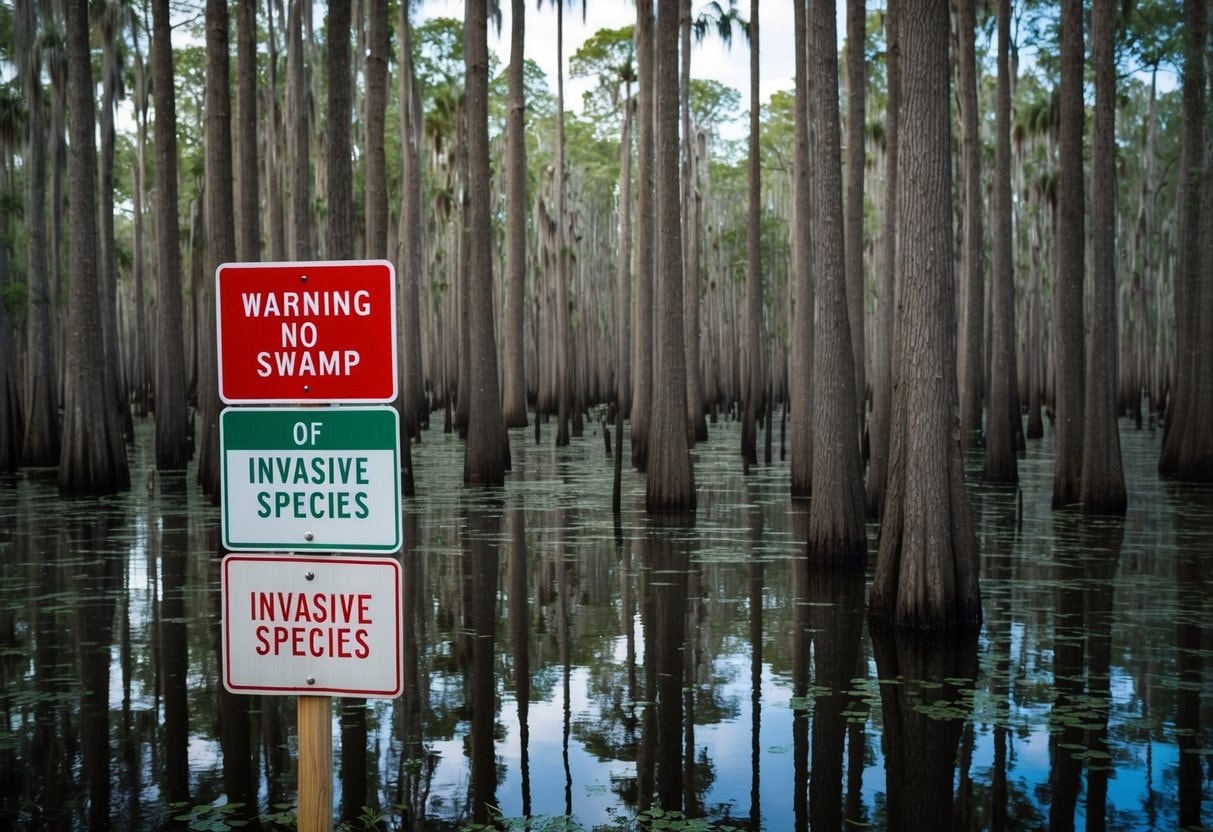
Florida takes invasive species seriously. The Florida Fish and Wildlife Conservation Commission (FWC) plays a big role in ensuring everyone follows the rules. The FWC has set up some helpful grace periods regarding the regulations and policies on invasive species in Florida.
These periods give people time to adjust to new rules about invasive species. There’s a 90-day Grace Period for some situations. This gives folks a bit of time to get their ducks in a row. For bigger changes, there’s a 180-day Grace Period. This longer time helps people make bigger adjustments if needed.
The FWC also offers a Limited Exception Commercial Use Permit. This permit helps businesses working with certain species keep operating while following the rules. Inspectors from the FWC check to make sure everyone’s following the rules. They can visit places that keep invasive species to ensure everything’s okay.
If someone breaks the rules, they might have to pay a fine. In some cases, they might even lose their permit to keep certain animals. The FWC tries to be fair. They work with people to help them understand and follow the rules. Their goal is to protect Florida’s native plants and animals while being nice to everyone.
Did You Know?
To obtain a license for hunting invasive species within Florida, hunters need a Florida hunting license. While some invasive animals do not require a special permit to hunt, others, such as pythons, necessitate additional training. The Florida Fish and Wildlife Conservation Commission (FWC) website provides detailed information on obtaining these licenses.
Impact Assessment
Invasive species can shake things up in Florida’s ecosystems. These unwanted guests often cause big problems for the state’s native plants and animals, prompting the development of regulations and policies on invasive species in Florida to manage their impact. Let’s look at some of the ways invasive species affect Florida:
- They can push out native species
- They may change how ecosystems work.
- Some damaged crops and gardens
- A few can even spread diseases.
The Everglades face special challenges from invasive plants and animals. These unique wetlands are home to many rare species found nowhere else. Experts use different tools to figure out how bad an invasive species might be. They look at things like:
- How fast it spreads
- What it eats or competes with
- If it can survive Florida’s climate
Florida’s rich biodiversity is at risk from these invaders. Many native species are already struggling. Adding invasive competitors makes things even harder for them.
Ecological risk assessments help scientists understand the threats. These studies look at how an invasive species might affect Florida’s environment. Florida can make better plans to protect its amazing ecosystems by studying these impacts.
Check out this video about the Florida Fish and Wildlife Conservation Commission (FWC).
By: General Discharge
Protecting Florida’s Ecosystems: A Deep Dive into Regulations on Invasive Species
Regulations and policies on invasive species in Florida are vital for preserving the state’s rich biodiversity and ensuring the health of its ecosystems. These regulations are designed to manage non-native species that threaten Florida’s unique flora and fauna, such as Burmese pythons and Brazilian pepper trees. Florida aims to mitigate the impacts of invasive species by banning the ownership of certain invasive reptiles and promoting early detection and rapid response strategies. The commitment of state agencies and local organizations to enforce these policies demonstrates a proactive approach to conservation, protecting both the environment and the economy.
Additionally, community involvement is crucial in the fight against invasive species. By educating the public about the regulations and policies on invasive species in Florida, authorities empower citizens to recognize and report invasive threats, fostering a culture of stewardship and responsibility. The collective efforts of government, research institutions, and local communities create a robust framework for managing invasive species. With continued vigilance and cooperation, Florida can safeguard its natural landscapes for future generations while preserving the state’s ecological integrity.
Frequently Asked Questions
What's Inside
- What Plants Are Considered Illegal to Cultivate in Florida Due to Their Invasive Status?
- Which Species Have Been Included on the Florida Fish and Wildlife Conservation Commission's Prohibited Species List?
- What Regulations Are in Place for Owning Non-native Snakes in Florida?
- What Are Some Strategies Recommended for the Management and Control of Invasive Plants and Animals in Florida?
- Can You List Some of the Worst Offending Invasive Plants That Are Causing Ecological Issues in Florida?
What Plants Are Considered Illegal to Cultivate in Florida Due to Their Invasive Status?
Florida bans many invasive plants. Brazilian pepper and melaleuca are not allowed. Neither are water hyacinth and hydrilla. These plants spread quickly. They harm local ecosystems. It’s against the law to grow or sell them in Florida.
Which Species Have Been Included on the Florida Fish and Wildlife Conservation Commission's Prohibited Species List?
The FWC list includes many animals. Burmese pythons and Nile monitor lizards are on it. So are green iguanas and tegus. These animals can’t be owned as pets. They also can’t be brought into Florida. The list aims to protect native wildlife.
What Regulations Are in Place for Owning Non-native Snakes in Florida?
Florida has strict snake rules. Owners need permits for some species. This includes reticulated pythons and green anacondas. Owners must follow cage rules. They also need to report escapes. These laws help control invasive snake populations.
What Are Some Strategies Recommended for the Management and Control of Invasive Plants and Animals in Florida?
Florida uses many control methods. They remove plants by hand and machine. They also use safe chemicals. For animals, they allow hunting. They set traps, too. Education is key. Florida teaches people about invasive species dangers.
Can You List Some of the Worst Offending Invasive Plants That Are Causing Ecological Issues in Florida?
Hydrilla is a major problem. It clogs waterways. Brazilian pepper crowds out native plants. Melaleuca trees drink too much water. They harm wetlands. Kudzu vines smother other plants. These invaders change Florida’s natural areas.
Uncover the Treasures of Florida: Kayaking, Manatees, and Beyond!
Are you eager to discover the splendors of Florida from a fresh perspective? Become a member of Florida Splendors, your gateway to a vibrant online community that adores kayaking, manatees, and the captivating beauty of the Sunshine State.
Connect with us on:

